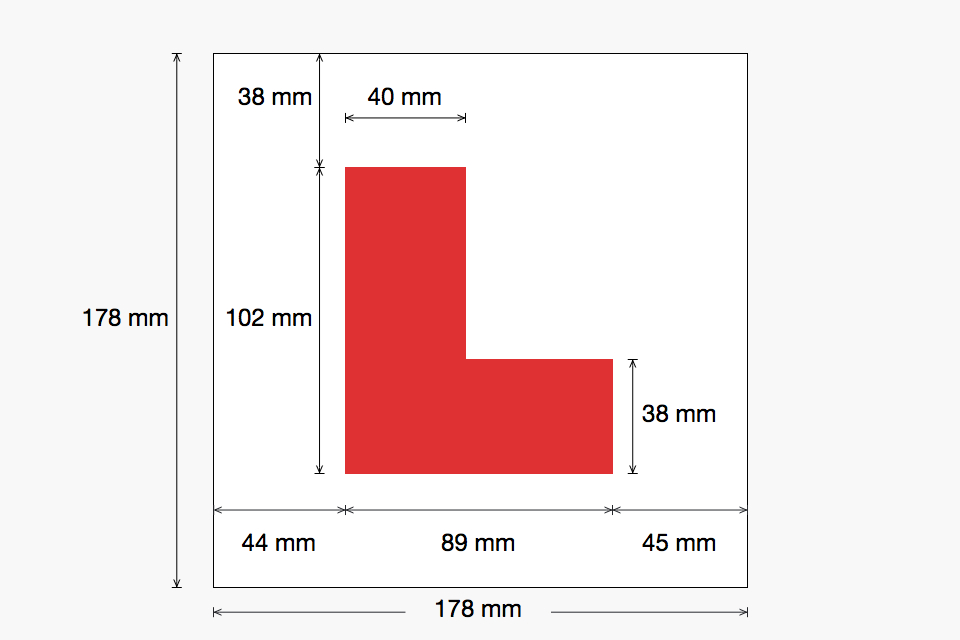Another topic that crops up constantly is the display of L plates (or D Plates for those in Wales).
The regulations regarding the Display of L plates are contained within:

Conditions attached to provisional licences
16.—(1) A provisional licence of any class is granted subject to the conditions prescribed in relation to a licence of that class in the following paragraphs.
“unless a distinguishing mark in the form set out in Part 1 of Schedule 4 is displayed on the vehicle in such manner as to be clearly visible to other persons using the road from within a reasonable distance from the front and from the back of the vehicle,“
That should answer the first statement that “The L plate on the top box has to be above the driver”.
The only requirements for placement within the regulations are that shown above .
Part 1 – Schedule 4
L plate sizes – GOV.UK (www.gov.uk) is a more user friendly version of Part 1 Schedule 4 The Motor Vehicles (Driving Licences) Regulations 1999 (legislation.gov.uk).
This section details the size requirements for the “Distinguishing Mark”. Note there is no variance given in the legislation, they are not listed as “maximum” or “minimum” sizes.
The only variation allowed is for the corners to be rounded off.
This means that if the L plate is not of the correct dimensions, then a provisional licence holder is driving otherwise than in accordance with a licence. The penalty of which could be as high as a £1000 fine, 6 points, and a driving ban. It is also an offence to “use, cause, or permit, driving otherwise than in accordance with a licence” so the supervising driver or ADI/PDI could be liable as well.
In my experience there 3 types of non-compliant L plates.
Moped riders, who often trim the white area down so that’s it’s little more than a border around the L
Cheap L plates bought off the internet – these usually look “wrong” as soon as you see them
Top boxes used by instructors!
Yes many (but not all) top boxes do not have the required dimensions. As long as you are also displaying L plates on the car this isn’t a problem.
The easiest way to check is to hold a standard L plate up against the one on the top box.
However, there is one more thing to consider both relating to Topboxes and the question that sometimes arises on white cars. The white border has to be 178mm square so on some topboxes this will be bigger or smaller.
It’s for this reason you can’t just have a sign written red L on a white car. It would also need a sign written border around it to the correct dimensions. (Or just use a normal L plate).
Finally do L plates have to be removed when driven by a FLH?
There is some confusion around this topic not helped by the Highway Code which suggests “Plates should be removed or covered when not being driven by a learner (except on driving school vehicles).”
First of all, the word “should”, and secondly the only legislation referred to by the HWC is linked to in this article.
Nothing specifies that a FLH cannot display L plates. It would make little sense anyway as lots of driving school cars are unmarked except for L plates, so how would you tell the difference? does the “driving school vehicle” statement only apply when being driving by an instructor, or should they be covered when a family member is driving the car as well?
The original ADI qualifying exam required you display L plates for phases when the examiner was portraying a learner, and the DVSA require L plates to be displayed on driving tests even when the candidate is entitled to drive without them i.e: converting Grandfather rights or foreign nationals taking a UK test.
If it was illegal for a FLH to display L plates, then all these scenarios would require an exemption in law, but you won’t find one because it’s not illegal in the first place.
Of course, if you were a provisional licence holder thinking of driving unaccompanied, why would you display L plates to further bring attention to yourself? If anything, you’d remove them. (See this article here, there’s no L plates showing the photo)

